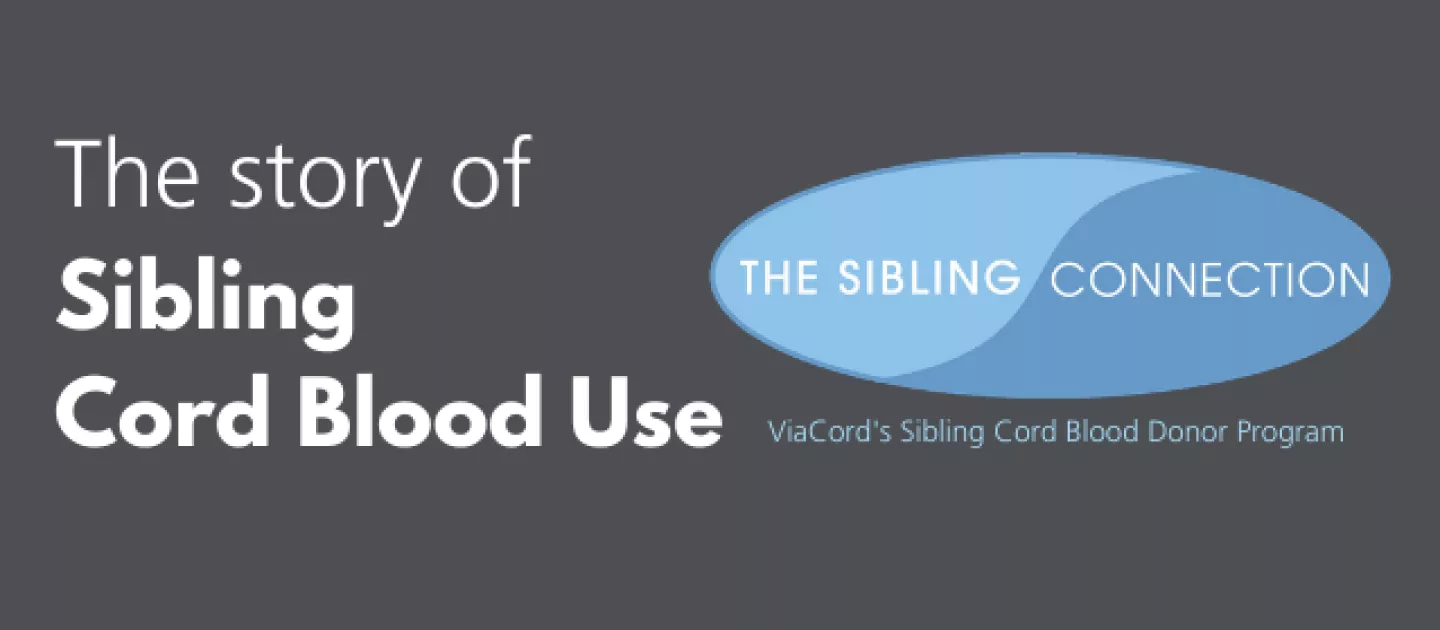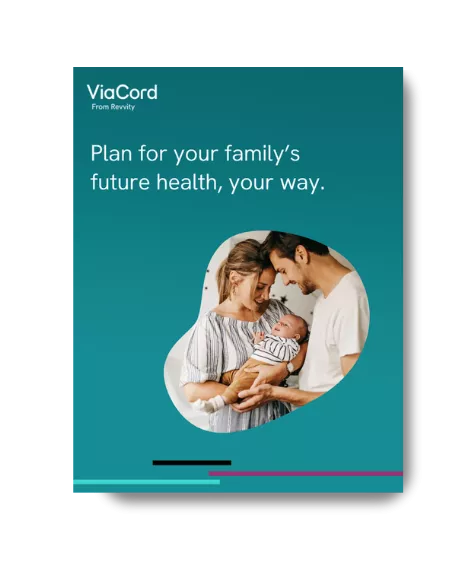A Long History of Helping Those Who Need It Most
At ViaCord, we’ve seen first-hand, the life-saving role a sibling’s cord blood can play in transplants. That’s why we’ve offered a sibling cord blood donor program for over 25 years, helping nearly 9,000 families bank cord blood for potential use in a transplant.1 Today, our sibling cord blood donor program, The Sibling Connection, provides ViaCord’s high-quality cord blood processing and life-time storage at no cost to families who meet eligibility requirements of the program. Before we get into how ViaCord’s Sibling Connection Program works, let’s take a quick ride in our stem cell transplant time machine and see how the first sibling cord blood transplant came about. Ready? Let’s go . . .
The Start of Sibling Cord Blood Use
The story of how the first sibling cord blood transplant came about is a pretty cool one. It involves well known researchers and doctors in the field of stem cell medicine, who at the time, were at various stages in their careers and a five-year-old little boy, named Matthew. Together they would make history.
The setting is the mid-1980s at Duke University. Dr. Joanne Kurtzberg, who today is a renowned expert in pediatric hematology/oncology, pediatric blood and marrow transplantation, umbilical cord blood banking and transplantation, and research using cord blood in the emerging fields of cellular therapies and regenerative medicine, was in her Pediatric Hematology/Oncology fellowship at Duke. Her mentor was Dr. Hal Broxmeyer, who today is internationally recognized for his groundbreaking research into lifesaving umbilical cord blood transplantation.
As part of her fellowship, Dr. Kurtzberg cared for children with leukemias and blood disorders. A young boy she was caring for in the clinic, Matthew, had Fanconi anemia (FA) – a rare but serious blood disorder. FA is an inherited disease caused by mutations in certain genes. The mutation prevents bone marrow from making enough new blood cells for the body to work normally and can also produce abnormal blood cells.2 Most children with Fanconi Anemia die of bone marrow failure or leukemia in the first decade of their life. At the time, the only potential cure for FA was stem cell transplant using bone marrow stem cells donated from a relative that genetically matched the Matthew. The donated stem cells had to be a genetic match for his immune system to accept them. Rejection was not an option. Unfortunately, Matthew did not have a living related matched donor.3
A New Hope Is Born
Although Matthew did not have a living related matched donor, his mother found out she was expecting another baby. The prospect that Matthew’s unborn sibling could be a healthy match for him provided new hope for Matthew. Through prenatal testing, doctors confirmed Matthew’s soon to be born little sister 1) did not have FA and 2) was a perfect genetic match!
As mentioned, bone marrow was the standard source of stem cells for transplant at that time. However, five years earlier, Dr. Hal Broxmeyer, Dr. Kurtzberg’s mentor, and a team of colleagues at Memorial Sloan Kettering Cancer Center (MSKCC) first proposed using umbilical cord blood as a source stem cells in transplant. Their research had confirmed that cord blood was a rich source of HSCs —even more so than bone marrow—and hypothesized that cord blood could serve as a substitute donor for bone marrow transplantation.4
When The Pieces Fall Into Place
When it was confirmed that Matthew’s sister was a perfect match, the great minds working on Matthew’s case came together and everything started to fall into place…
There was a child patient in need. There was no related bone marrow donor available. Dr. Broxmeyer and his colleagues had proven that cord blood could provide the necessary HSCs. The stem cells in the unborn baby’s cord blood were a perfect match. Preliminary testing of the concept of using cord blood HSCs had been performed in mice…the pieces were falling into place.
The team of doctors talked with Matthew’s parents, who talked with Matthew (then 5 years old), to see if he was on board with the transplant. It was Matthew who ultimately made the final decision, which was yes.
History In The Making
Matthew’s newborn sister, and hope for a ‘new life’, was born in North Carolina. Her umbilical cord blood was collected, processed and cryogenically stored by Dr. Broxmeyer at the Memorial Sloan Kettering Cancer Center lab. When it was time to perform the transplant, Dr. Broxmeyer flew to Paris, France with the frozen cord blood stem cells in the airplane seat next to him! The transplant was performed by Dr. Eliane Gluckman, an expert in transplantation of patients with Fanconi Anemia at the L'Hopital St. Louis in Paris. Matthew’s sister’s cord blood stem cells engrafted 19 days after the transplant, essentially curing Matthew of his Fanconi Anemia…and making transplant history.
Today, Matthew is healthy, living his best life as a Dad!
Recognizing The Value of Sibling Cord Blood
Thanks to the work of experts in the stem cell field, like. Dr. Kurtzberg, Dr. Broxmeyer, and Dr. Gluckman we know the value of cord blood as a source of HSCs and the benefits of using sibling cord blood including:
Matching: A sibling provides the best odds of finding a perfectly matched related source of stem cells.6
Success Rate: Treatments using cord blood from a family member are about twice as successful as those from a non-relative.7
ViaCord’s Sibling Connection Program
ViaCord’s Sibling Connection Program may be available to any expectant family with a child who has an established diagnosis that is currently treatable with a sibling cord blood transplant, and:
1. The baby whose cord blood will be stored must be a full sibling (same biological parents) of the child in need.
2. The child in need must have one of the diseases that are currently treatable with sibling cord blood in transplant.
3. Medical Referral form completed by the sibling’s treating physician
Why Families Choose ViaCord’s Sibling Connection Program
As a leader in cord blood banking for over 25 years and part of a global healthcare company, PerkinElmer, ViaCord offers families confidence and trust. Cord blood units banked by ViaCord have a great track record with the highest published transplant success rate in Family Banking at 1 year.8
Meet They Byrd Family When the Byrd Family’s son Blase was diagnosed with cancer,
Mom Tami was expecting her second child. They saved their baby’s cord blood with the Sibling Connection Program and used it for Blase’s stem cell transplant. Blase is now a healthy young boy living life to the fullest.
If you think your family, or someone you know, may qualify for our Sibling Connection Program learn more here, or call to speak to one of our Sibling Connection Specialists 1-866-861-8435
Disclaimer: Banking cord blood does not guarantee that treatment will work and only a doctor can determine when it can be used. Cord tissue stem cells are not approved for use in treatment, but research is ongoing. PerkinElmer does not endorse or make recommendations with respect to research, medication, or treatments. All information presented is for informational purposes only and is not intended as medical advice.
References:
- Data on File, ViaCord. Access June 2020.
- National Heart Lung and Blood Institute, Health Topics: Fanconi Anemia https://www.nhlbi.nih.gov/health-topics/fanconi-anemia
- Kurtzberg J. A History of Cord Blood Banking and Transplantation. Stem Cells Transl Med. 2017;6(5):1309-1311. doi:10.1002/sctm.17-0075 https://www.ncbi.nlm.nih.gov/pmc/articles/PMC5442723
- https://cancer.iu.edu/news-publications/Broxmeyer_grant.shtml
- https://www.ncbi.nlm.nih.gov/pmc/articles/PMC5442723/
- The probability of finding a donor stem cell source through a public bank is low. Banking cord blood with a family bank increases the chances of having a matched unit available. Beatty PG, Boucher KM, Mori M, Milford EL. Probability of finding HLA-mismatched related or unrelated marrow or cord blood donors. Hum Immunol. 2000;61(8):834-840. Gluckman E, Rocha V, et al. Factors associated with outcomes of unrelated cord blood transplant: Guidelines for donor choice. Experimental Hematology. 32 (2004) 397–407.
- Outcome of Cord-Blood Transplantation from Related and Unrelated Donors Eliane Gluckman, M.D., Vanderson Rocha, M.D., Agnès Boyer-Chammard, M.D., Franco Locatelli, M.D., William Arcese, M.D., Ricardo Pasquini, M.D., Juan Ortega, M.D., Gérard Souillet, M.D., Euripedes Ferreira, M.D., Jean-Philippe Laporte, M.D., Manuel Fernandez, M.D., and Claude Chastang, M.D., Ph.D. for the Eurocord Transplant Group and the European Blood and Marrow Transplantation Group*











